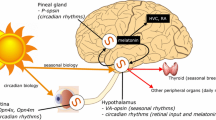Abstract
The phototactic response of the nauplius larva of Balanus balanoides, B. crenatus and Elminius modestus shows darkadaptation; the response of the cyprid of B. balanoides shows both phototaxis and low photokinesis. The phototactic responses and the orientation of the cyprid to white light at settlement require an intensity of illumination slightly above 10-5 lux. The ability to select a shaded position by cyprids of R. balanoides requires a higher intensity of 10-2 to 10-4 lux; hence a different mechanism may be involved. Barnacle larvae are sufficiently sensitive to be able to respond to light beneath the sea surface, even on cloudy, moonless nights.
Similar content being viewed by others
Literature Cited
Aldous, J.: A study of the fine structure of the nauplius eye. M. Sc. thesis, University of Wales 1968
Barnes, H., D. J. Crisp and H. T. Powell: Observations on the orientation of some species of barnacles. J. Anim. Ecol. 20, 227–241 (1951).
— and W. Klepal: Phototaxis in Stage I larvae of two cirripedes. J. exp. mar. Biol. Ecol. 10, 267–273 (1972).
Blaxter, J. H. S.: Light intensity vision and feeding in young plaice. J. exp. mar. Biol. Ecol. 2, 293–307 (1968).
—: Visual thresholds and spectral sensitivity of flatfish larvae. J. exp. Biol. 51, 221–230 (1969).
Bousfield, E. L.: Ecological control of the occurrence of barnacles in the Miramichi estuary. Bull. natn. Mus. Can. (Ser. biol.) 46 (137), 1–69 (1955).
Brown, D. R. E.: Natural illumination charts. Research and Development Project N S 714-100. U. S. Dept. of the Navy, Bureau of Ships, Washington 25 D. C. 1952.
Crisp, D. J. and A. F. A. A. Ghobashy: Responses of the larvae of Diplosoma listerianum to light and gravity. In: Fourth European Marine Biology Symposium, Bangor 1969, pp 443–465. Ed. by D. J. Crisp. Cambridge: Cambridge University Press 1971
— and P. S. Meadows: The chemical basis of gregariousness in cirripedes. Proc. R. Soc. (Ser. B) 156, 500–520 (1962).
Ewald, W. E.: On artificial modifications of light reactions and the influence of electrolytes on phototaxis. J. exp. Zool. 13, 591–612 (1912).
Forbes, L., M. J. B. Seward and D. J. Crisp: Orientation to light and the shading reaponse in barnacles. In: Fourth European Marine Biology Symposium, Bangor 1969, pp 539–558. Ed. by D. J. Crisp. Cambridge: Cambridge University Press 1971.
Fraenkel, G. and D. Gunn: The orientation of animals. Monographs on animal behaviour, 352 pp. Oxford: University Press 1940
Harris, J. E.: Physical factors involved in the vertical migration of plankton animals. Q. Jl microsc. Sci. 94, 537–550 (1953).
Kauri, T.: On the frontal filaments and nauplius cye in Balanus. Crustaceana 1962 (4), 132–142 (1962).
Knight-Jones, E. W. and D. J. Crisp: Gregariousness in barnacles in relation to the fouling of ships and to anti-fouling research. Nature. Lond. 171, p. 1109 (1953).
— and E. Morgan: Responses of marine animals to changes in hydrostatic pressure. Oceanogr. mar. Biol. A. Rev. 4, 267–299 (1966).
Mosby, H.: Verdunstung und Strahlung auf dem Meere. Annln Hydrogr., Stralsund 64, 281–286 (1936).
Powell, W. M. and G. L. Clarke: The reflection and absorption of daylight at the surface of the ocean. J. opt. Soc. Am. 26, 111–120 (1936).
Qasim, S. Z. and E. W. Knight-Jones: Further investigations on the pressure responses of marine animals. Rep. Chailenger Soc. 3, p. 21 (1957).
Rice, A. L.: Observations on the effects of changes of hydrostatic pressure on the behaviour of some marine animals. J. mar. biol. Ass. U. K. 44, 163–175 (1964).
Ritz, D. A.: Behavioural response to light of newly hatched phyllosoma larvae of Panulirus longipes cygnus George (Crustacea: Decapoda: Palinuridae). J. exp. mar. Biol. Ecol. 10, 105–119 (1972).
Schmidt, W.: Strahlung und Verdunstung an freien Wasserflächen; ein Beitrag zum Wärmehaushalt des Weltmeers und zum Wasserhaushalt der Erde. Annln Hydrogr. Berl. 43, 111–124 (1915).
Sverdrup, H. U., M. W. Johnson and R. H. Fleming: The oceans, 1087 pp. New York: Prentice Hall 1942.
Thorson, G.: Light as an ecological factor in the dispersal and settlement of larvae of marine bottom invertebrates. Ophelia 1, 167–208 (1964).
Utterback, C. L.: Spectral bands of submarine solar radiation in the North Pacific and adjacent inshore waters. Rapp. P.-v. Réun. Cons. perm. int. Explor. Mer. 101 (Part 2, No. 4), 1–15 (1936).
Wood, L. and W. J. Hargis: Transport of bivalve larvae in a tidal estuary. In: Fourth European Marine Biology Symposium, Bangor 1969, pp 29–44. Ed. by D. J. Crisp. Cambridge, Cambridge University Press 1971.
Author information
Authors and Affiliations
Additional information
Communicated by J. H. S. Blaxter, Oban
Rights and permissions
About this article
Cite this article
Crisp, D.J., Ritz, D.A. Responses of cirripede larvae to light. I. Experiments with white light. Marine Biology 23, 327–335 (1973). https://doi.org/10.1007/BF00389340
Accepted:
Issue Date:
DOI: https://doi.org/10.1007/BF00389340




